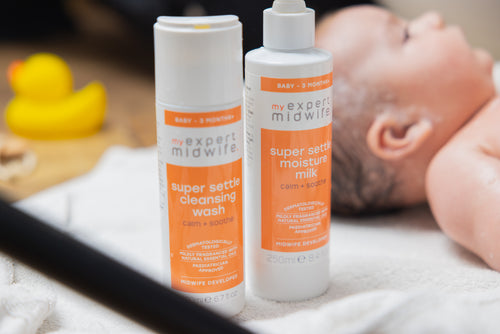Our skin provides protection to our whole bodies to stop harmful bacteria, allergens and chemicals entering, as well as helping regulate our water balance and temperature. As with other organs in the body a baby’s skin is immature and needs gentle and careful treatment to develop. The skin of a baby is approximately 30% thinner than that of an adult, even thinner in those babies born prematurely, until they are about 2 years old. Babies also lose moisture from their skin more easily, have lower levels of natural moisturising factors and so their skin is more prone to damage, dryness and infections.
To help care for your baby’s skin from birth follow our 7 essential steps to expertly care for your baby’s skin.
Download our 7 Essential Steps to Expertly Caring For Your Baby's Skin here.
Whilst in the womb a thick waxy coating called vernix, which is packed full of fats, proteins and moisturising factors, protects them against infection, regulates baby’s temperature, reduces water loss and prevents damage and dryness. Once they are born a baby’s skin flora and microbiome start to develop.
A baby’s microbiome is literally an army of trillions of microbes which help to protect them from diseases and infections. We all have our own unique microbiome and the best way to help your baby develop theirs is to have regular skin-to-skin contact from birth.

The microbiome of your baby which helps to protect them against infections and diseases are unique to each baby and are acquired from the environment around them, so continue skin-to-skin contact after their birth and build this into their regular daily routine.
Skin flora and the microbiome are a community of bacteria, viruses and fungi all of which have particular protective functions in supporting our immune systems. Therefore, gentle care should be taken not to disturb this balance as the microbiome starts to establish after birth, for example delaying bathing, by top and tail cleaning of baby in the first few days after birth. You can learn more here with our 7 essential steps to caring for your baby’s skin.
Read more about the microbiome here
Skin-to-skin contact is often associated with the immediate time after baby has been born, but a baby can benefit enormously from skin-to-skin contact being built into their daily routine too. Regular, daily skin-to-skin contact with your baby can help support their developing skin flora and microbiome as this helps your baby gain microbes from their family and the environment around them.
read more about skin-to-skin here
- It helps to develop your baby’s microbiome which is the skin flora and microbes we all have and need to help protect us against infections and diseases
- It keeps baby close to the breast to help establish breastfeeding
- Your baby feels safe, so they’re calm and settle more easily as they know your heartbeat, breathing, and the sound of your voice
- It’s great to promote the hormone oxytocin which not only helps with bonding, but can reduce bleeding and help breastmilk to flow

Your baby’s skin is delicate and requires nurturing so it is able to develop and provide the best protection possible. Damage and disturbance to their skin can lead to long-term problems such as eczema, infection and dryness.
During pregnancy you can plan to welcome your baby by having skin-to-skin contact immediately after birth and continue to build skin-to-skin into their daily routine.
Avoid bathing baby too soon and top and tail your baby for the first few days.
In their first few weeks bathing your baby maximum of two to three baths a week is sufficient unless visibly dirty and this will help to avoid over-drying baby’s skin. Choose products which are gentle and designed for baby’s skin and spend plenty of time skin-to-skin with your baby.

Giving your baby their first bath can be both exciting and a bit scary, so having an extra pair of hands the first few times is helpful. Chose a time when baby is calm and at least half an hour after a feed, so their tummy has settled down.
Decide where you are going to bath baby. You may feel safer sitting on the floor, or more comfortable standing up, with the baby bath in a sink or on a worktop surface. Ensure the room is warm as babies quickly lose heat.
Be prepared for your baby to cry initially, this is normal as they get used to being bathed.

- Wash your hands. Gather everything together - cotton pads, sponge, clean nappy, clothes, two towels (warm up on a radiator)
- Fill the baby bathtub, first with cold water, then hot and a gentle cleansing wash product until bath water feels warm (between 37° - 38°C). Use a thermometer or your wrist or elbow to check. When using a sink, finish with cold water to cool the taps
- Place your non-dominant arm under baby so their head and neck rest in the crook of your elbow and hold their forearm. Use your other hand to hold baby’s leg and nappy area. Slowly introduce your baby into the water, keeping their head clear
- Wash baby with the sponge - clean into any creases such as around their legs and neck. Talking or singing can help to relax both you and your baby
- After a few minutes, lift baby out onto a warm towel. Wrap up and dry thoroughly then use a gentle moisturiser
- This is a good time to have skin-to-skin with your baby to encourage repopulation of their skin microbiome










